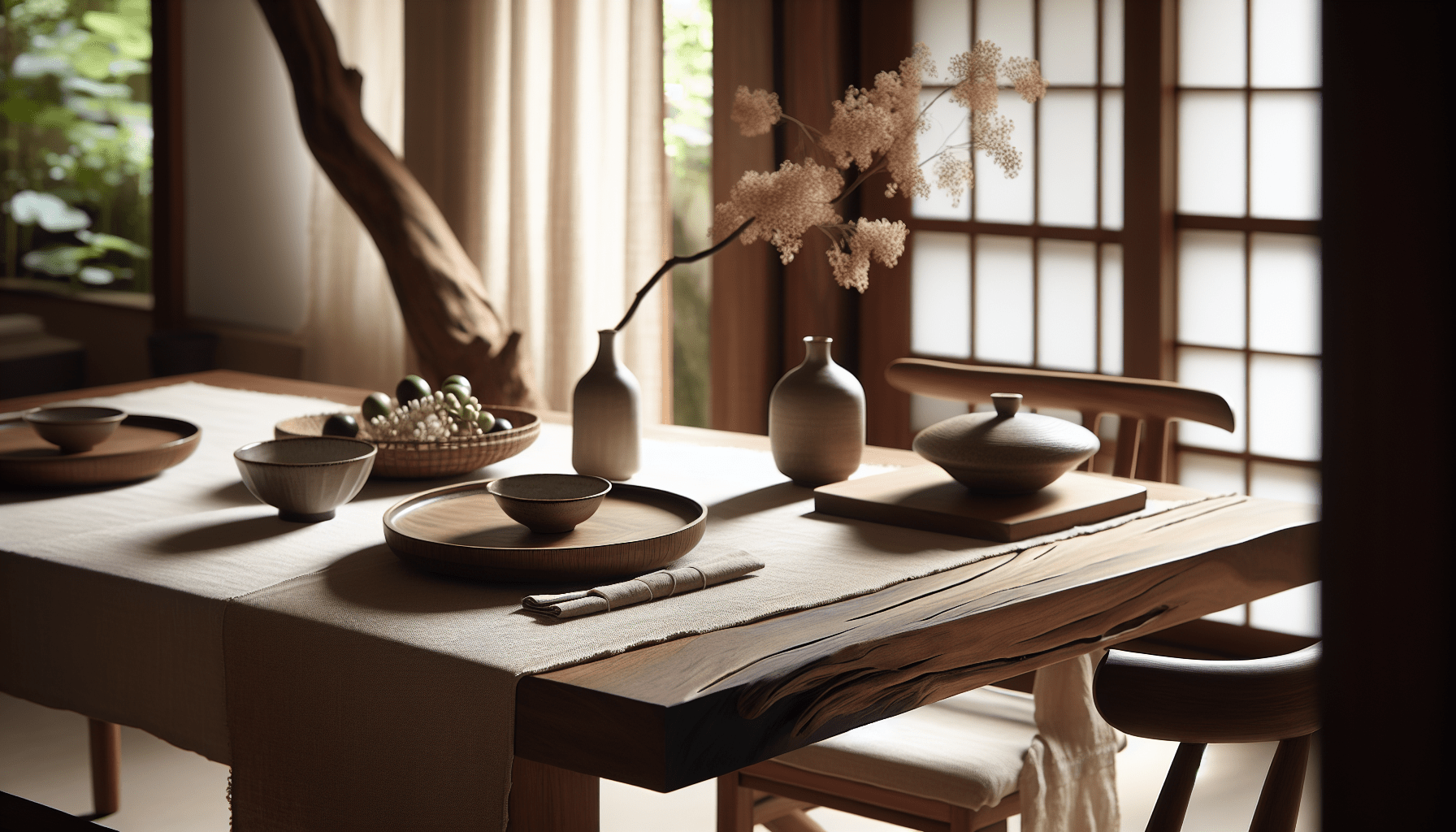How do you choose the right Japandi-style dining table for your home? This can be a thought-provoking question, especially if you’re looking to infuse your dining space with a warm, minimalist aesthetic that combines Japanese and Scandinavian influences. The right dining table not only serves as a functional piece of furniture but also serves as the centerpiece of your dining area, potentially shaping the overall ambiance of your home.
Understanding Japandi Style
Before jumping into the selection process for your dining table, let’s take a moment to connect with the philosophy behind Japandi style. Japandi merges the simplicity of Scandinavian design with the elegance of Japanese aesthetics. It’s all about creating a serene, clutter-free environment filled with natural materials, muted colors, and functional beauty.
Key Characteristics of Japandi Style
Familiarizing yourself with the main characteristics of this design style can help you make an informed choice. Here are some important aspects:
- Minimalism: Clean lines and a lack of excessive decoration.
- Natural Materials: Use of wood, ceramics, and textiles that highlight nature.
- Warm Hues: Soft, earthy colors to create a cozy atmosphere.
Understanding these characteristics will guide you toward a dining table that not only matches the aesthetic but enhances it.
Size Matters
When thinking about your dining table, the size should be one of the first factors to consider. A table that is too large can overwhelm your space, while one that’s too small may not accommodate your needs.
Measuring Your Space
Before you rush into shopping, take the time to measure your dining area. Here’s how to make your measurements effective:
- Length & Width: Ensure there’s enough space to maneuver around the table. Ideally, you should have at least 36 inches of clearance on each side.
- Height: Standard dining table height ranges from 28 to 30 inches, but you might want to consider how comfortable you feel seated around the table.
This is how you can visualize your space:
| Measurement | Recommended Space |
|---|---|
| Clearance around | 36 inches minimum |
| Dining Table Height | 28-30 inches |
By keeping these measurements in mind, you can avoid any unpleasant surprises when your table arrives.
Shape of the Table
The shape of your dining table can significantly impact the look and feel of your dining area. Depending on your space and preference, you might consider different shapes.
Common Table Shapes
- Rectangular: Ideal for narrow spaces; can seat more people comfortably.
- Round: Promotes conversation and is great for smaller spaces.
- Square: Provides a contemporary look and fits well in square rooms.
Choosing the Right Shape
To choose the best shape for your dining table, consider your lifestyle and space configuration. A rectangular table may suit larger gatherings, while a round table encourages intimacy during smaller meals.
Material Choices
Material plays a crucial role in both aesthetics and functionality. The perfect Japandi-style dining table often features natural materials that promote warmth and simplicity.
Popular Materials
- Solid Wood: A classic choice that brings warmth to your space. Look for oak or walnut for durability and strength.
- Bamboo: An eco-friendly alternative that’s both stylish and sustainable.
- Ceramic: Often used in table tops, this material adds a unique touch when combined with wood.
Pros and Cons of Different Materials
| Material | Pros | Cons |
|---|---|---|
| Solid Wood | Durable, Warm, Timeless | Can be expensive |
| Bamboo | Sustainable, Lightweight | May not be as sturdy |
| Ceramic | Unique aesthetics | Prone to cracking if mishandled |
Selecting the appropriate material gives you a chance to not only enhance your dining experience but also express your personality through your decor.
Color Palette
The color of your dining table should blend harmoniously with your overall interior. A Japandi-style dining table often features natural tones that complement the earthy and serene atmosphere.
Ideal Color Choices
- Natural Wood Tones: These include light oaks or deep walnut shades.
- Soft Neutrals: Whites, greys, and soft beige can make your space feel larger and more inviting.
- Muted Pastels: Introducing a hint of color can bring a fresh vibe without overwhelming the subtle aesthetic.
Color in Context
When selecting the color for your table, consider the wall colors, surrounding furniture, and other decor elements in your dining area.
Functionality and Purpose
Identifying how you will be using your dining table can guide your choice significantly.
Everyday Use vs. Entertaining
- Everyday Use: If the table will serve as a central point for meals, consider materials that are easy to clean and maintain.
- Entertaining: A more robust design may be necessary to accommodate more guests and withstand frequent use.
Multi-Functional Tables
You may also want to consider multi-functional designs, such as extendable tables, which can adapt to your needs.
Style and Decor
Your dining table should not exist in isolation. It’s essential to think about how it’ll fit in with your overall decor style.
Incorporating Japandi Elements
To blend with the Japandi aesthetic, choose tables that highlight simplicity and elegance, avoiding overly decorative elements.
- Sleek Designs: Opt for uncomplicated silhouettes.
- Natural Finishes: Tables with a matte or semi-matte finish reflect the Japandi ethos.
Maintenance and Care
Once you’ve chosen the perfect table, understanding how to keep it in good condition is key.
Routine Cleaning Tips
- Dust Regularly: Use a soft cloth to remove dust and avoid buildup.
- Use Coasters: Protect the surface from rings and scratches by using coasters for drinks.
- Avoid Direct Sunlight: Keep your table out of direct sunlight to prevent fading.
Dealing with Damage
If you encounter scratches or dents, consider using furniture polish designed for wood to minimize their appearance.
Budgeting for Your Table
Understanding your budget will make the decision-making process easier.
Price Ranges
- Affordable: You can find basic dining tables that start at around $200, usually made from less durable materials.
- Mid-Range: Solid wood tables typically fall within the $400-$800 range.
- High-End: Custom or designer tables can exceed $1,000, often featuring intricate designs and high-quality materials.
Setting a Budget Snapshot
| Price Range | Table Material | Expected Quality |
|---|---|---|
| $200-$400 | Composite wood | Basic durability |
| $400-$800 | Solid wood | Good durability |
| $1,000+ | Designer options | Exceptional quality |
Determining your budget will help refine your search to tables that are both beautiful and practical.
Where to Shop
Once you’ve clarified your criteria, it’s time to start shopping. You have numerous options, both online and in physical stores.
Online Retailers
Shopping online can offer you a broader selection. Consider sites like:
- Wayfair: A good range of styles and prices.
- Overstock: Often features sales and discounts.
- West Elm: Known for modern and contemporary designs.
Local Stores
Visiting local furniture stores allows you to see the product firsthand. You’ll also have the opportunity to find unique pieces that aren’t available online.
Sustainability Considerations
As the trend toward sustainability grows, it may be essential for you to consider the environmental impact of your dining table.
Eco-Friendly Choices
- Reclaimed Wood: Tables made from reclaimed materials reduce waste and often feature unique histories.
- Bamboo: This fast-growing plant is a renewable resource, making it an eco-friendly option.
Choosing sustainable materials can not only be good for the environment but can also add character to your dining table.
Final Thoughts on Selection
Choosing the right Japandi-style dining table involves considering size, shape, material, color, and budget. It’s a decision that requires careful thought but can pay off in creating a warm, inviting atmosphere in your home.
Planning for the Future
Remember the dining table is not just a piece of furniture; it’s a place for memories, gatherings, and sharing. Consider how your choice today will impact those moments. You’ll want a table that allows for flexibility and adaptability as your needs change over time.
Your Journey Forward
As you set off on your journey to find the perfect dining table, keep these insights in mind. Take your time, be thoughtful in your decision-making, and ultimately, choose what resonates best with your style and lifestyle. Enjoy the process, and soon enough, you’ll be sitting around your new dining table making memories with family and friends.

